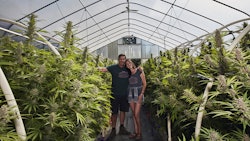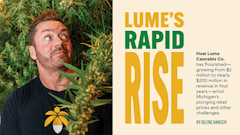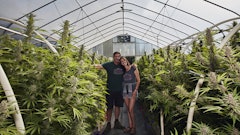
Cannabis cultivators curious about employing alternative cultivation methods received firsthand knowledge about approaches some of their peers are taking to regenerative growing techniques at Cannabis Conference 2022, where Mason Walker, co-founder and CEO of Oregon-based East Fork Cultivars, and Julia Jacobson, co-founder and CEO of California-based Aster Farms, took the stage to share the sustainable practices they have implemented at their outdoor farms.
In a panel moderated by Kevin Kuethe, chief cultivation officer at Michigan-based Lume Cannabis Co., Walker and Jacobson first defined what regenerative agriculture means to them.
For Walker, the terms “sustainable” and “regenerative” are frequently tossed around the industry and can mean different things, depending on who you talk to. He and the East Fork team define “regenerative farming” as identifying resources they use that have a negative impact on the environment—such as taking irrigation water from a river, for example—and working to not only reduce the use of those resources, but also regenerate the value of those resources for the farm’s future use.
Similarly, Jacobson defines regenerative farming practices as working within a living ecosystem, replenishing resources as they are used and creating a system that can replenish resources on its own.
Producing cannabis regeneratively has several benefits, Walker and Jacobson said, not just for the planet, but also for businesses.
For example, Walker shared that a neighboring hemp farm told him in early 2022 that it had to let part of its land lay fallow last year because the business could not afford the inputs to plant the entire acreage. Because East Fork’s regenerative practices allow it to use fewer outside resources, it was able to plant its full acreage despite the rising cost of pesticides and fertilizers.
“It was just such a stark, obvious example of the power of regenerative agriculture and regenerative choices in business,” Walker said. “With regenerative [farming], you are less reliant on global supply chains. You are less reliant on commodity pricing. You’re less reliant on other service providers.”
Jacobson shared that Aster Farms composts its green waste, which saves the business approximately $8,000 per year in the expenses required to bring compost onto the farm for its plants.
“There are direct financial benefits to literally reusing your waste and turning it into nutrients and cover and mulch for your crop,” she said.
Here, Walker and Jacobson share five innovative and regenerative growing techniques they use on their farms to create a closed-loop system and help preserve the planet.
1. Low-Till or No-Till Farming
Jacobson described tilling as the process of using a machine to blend the soil, breaking it up in preparation for planting crops. Tilling can kill beneficial insects in the soil, she said, and while it may be necessary when breaking ground for the first time, there are more natural ways to break up the soil and preserve its natural ecosystem, which can benefit cannabis crops.
“I think there’s mythology around low-till and no-till [farming] and it has a ton of value,” Walker said. “Those microorganism colonies in your soil are your workers and you really don’t want to break up their colonies and stop their work of keeping a healthy environment and breaking down macronutrients and micronutrients that your plants can use.”
East Fork is not a no-till farm—Walker said the team must till to add additional nutrients, like calcium, to the soil to help the plants thrive—but the company is working toward a no-till system.
In the meantime, Walker said East Fork has switched from high-depth, high-intensity tilling to spading, and has invested in a paddle spader that works the soil to incorporate the minerals while also keeping larger chunks of soil intact to allow microorganisms to thrive. East Fork also plants cover crops in the pathways between rows of cannabis plants so that soil-dwelling microorganisms can live there and eventually migrate to the cannabis crop.
“Spaders are great alternatives, and we cover crop also,” Jacobson said. “Once you get cover crop seed in and get cover crops going, we don’t even have to reapply cover crop at this point. Our cover crop just regrows every year. We’re growing three-foot-long daikon [radishes]. That is aerating. That is doing to the soil more and better than anything a piece of equipment could ever have done, and then it all just gets turned back into compost.”
2. Cover Crops
When it comes to cover crops, Walker said East Fork uses a more traditional mix of rye, clover and other native plants.
“Just the act of cover cropping is really powerful and can also apply to indoor and greenhouse [operations] as well as sungrown,” he said. “Monocropping is not great. It’s not really a regenerative practice. We’re growing a high-value crop. We’re growing under extreme regulation that makes it really difficult for you to do any sort of crop rotation because most states require you to grow your canopy in a fixed place and it’s really difficult to change where you’re growing it, and more expensive. So, with that in mind, I think we have to get creative as cannabis cultivators to incorporate good farming practices. Cover cropping is an essential one.”
Walker outlined three specific benefits of cover cropping: it prevents erosion, it pulls nitrogen from the air, and it adds biodiversity to the growing environment.
“I think the best advice you can follow is see what organic farmers do in your area,” he said. “They’ve got decades of wisdom and reasons that they choose those cover crops in those areas. There’s no need to reinvent the wheel.”
3. Habitat Preservation
East Fork works to preserve the natural habitat around its farm, and the company is conducting a multi-year study with the University of California, Berkeley, to determine the farm’s impact on the local wildlife.
UC Berkeley has set up camera traps all over East Fork’s 33-acre farm, which Walker said is in an area with a diverse population of migratory animals and insects. The study, now in its second year, is meant to monitor what impact East Fork’s fences and style of farming has on this wildlife.
“A lot of those creatures are part of a very intricate web and if you take one of them out—if you have a fence up that blocks the deer—it really impacts the environment and can destabilize your local environment,” Walker said.
The results of the study will help East Fork determine how to minimize the disruption of local wildlife and their habitats.
4. Companion Plants
Companion plants, or non-cannabis plants placed in and around cannabis to benefit the cannabis crop, are an important part of Aster Farms’ business, Jacobson said. The team plants companion seeds every year in the hopes of bringing beneficial insects to the cannabis plants.
Aster Farms also maintains a terpene garden, a non-cannabis garden that has pollinating plants, such as marigolds, that attract additional beneficial insects that can naturally mitigate pests.
“Work with nature instead of against it and put the bugs to work,” Walker said of East Fork’s similar companion plant strategy.
5. Composting
Aster Farms maintains a 10-foot by 12-foot structure with a roof and three sides that is open to the native soil, where the team places cannabis green waste, clippings from the terpene garden and other organic materials to make compost for the farm. The temperature of the compost pile is closely monitored; Jacobson said that when it starts to heat up, it’s a sign that the natural materials are starting to break down.
"It’s an incredible resource,” she said. “Regeneration is about creating these inputs on your property and not only on the property, but out of the cannabis waste itself. It’s a really closed-loop cycle. It doesn’t necessarily … fill all of our needs in terms of nutrients—it’s not the end all, be all—but we use it for both regular compost and we use it in some places for a thicker compost as a mulch of sorts. It’s great, and it’s super easy to do.”
Join us this year at the Paris Las Vegas Hotel & Casino for Cannabis Conference, the leading education and expo event for plant-touching businesses.

























